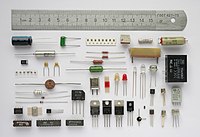
Photo from wikipedia
BACKGROUND Our study purpose was to determine the optimal glenoid and humeral reverse shoulder arthroplasty (RSA) component design and position in osteoarthritic shoulders with severe glenoid retroversion deformities. METHODS Computed… Click to show full abstract
BACKGROUND Our study purpose was to determine the optimal glenoid and humeral reverse shoulder arthroplasty (RSA) component design and position in osteoarthritic shoulders with severe glenoid retroversion deformities. METHODS Computed tomography scans from 10 subjects were analyzed with advanced software including RSA range of motion (ROM) analysis. Variables included glenoid component retroversion of 0°, 5°, 10°, 15°, and 20° and baseplate lateralization of 0, 5, and 10 mm. Humeral variables included 135°, 145°, and 155° angle of inclination (AOI) combined with variable humeral offset. RESULTS Glenoid component lateralization had the greatest influence on ROM. In comparing each ROM direction among all lateralization options independently, there were significantly greater adduction, abduction, external rotation, extension, and flexion motions with progressively greater lateralization. Internal rotation motion was greater at 10 mm only. In analyzing the effects of glenoid version independently, no differences in adduction or abduction ROM were seen. With greater retroversion, decreased external rotation and extension motion was noted; however, greater internal rotation and flexion motion was seen with the exception of flexion at 10 mm of lateralization. For adduction, external rotation, and extension, a more valgus AOI resulted in less ROM at each progressively greater AOI independent of humeral lateralization. Internal rotation and flexion motions were greater with a more varus AOI but not significant between each inclination angle. Abduction ROM was maximized with a more valgus AOI. Humeral lateralization had no effect on ROM. CONCLUSIONS In the setting of RSA for advanced glenoid osteoarthritic deformities, optimal ROM is achieved with 10-mm baseplate lateralization and neutral to 5° of retroversion mated to a humeral implant with a varus (135°) inclination angle.
Journal Title: Journal of shoulder and elbow surgery
Year Published: 2018
Link to full text (if available)
Share on Social Media: Sign Up to like & get
recommendations!